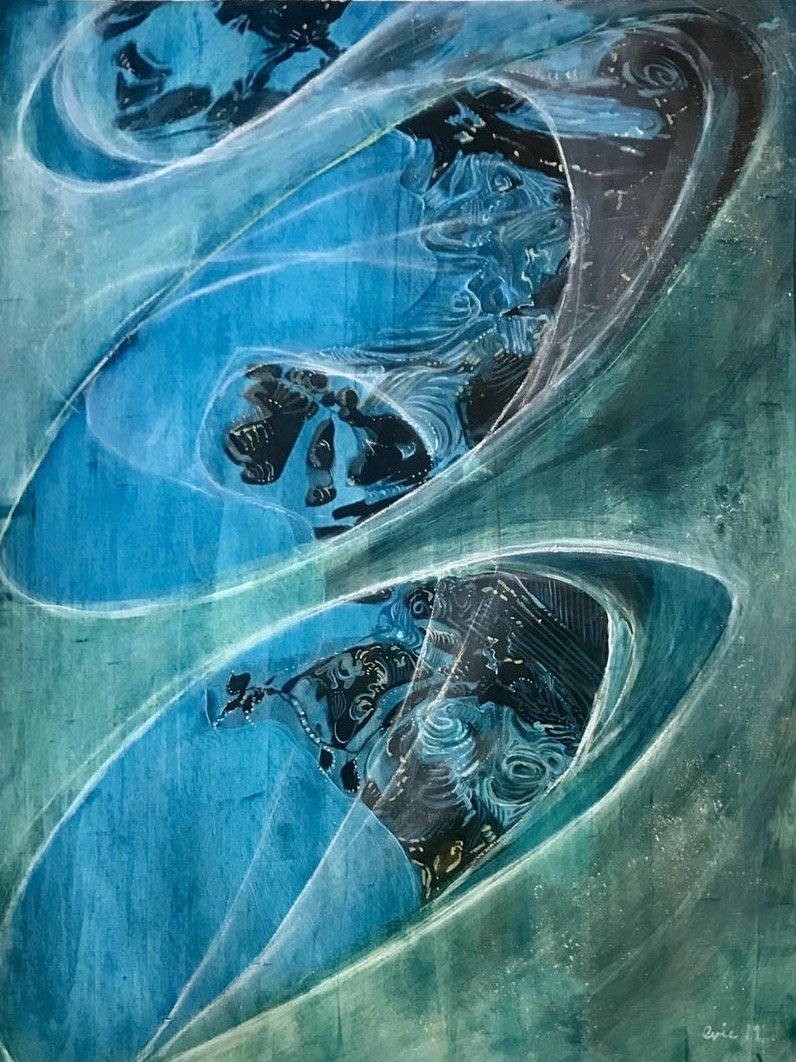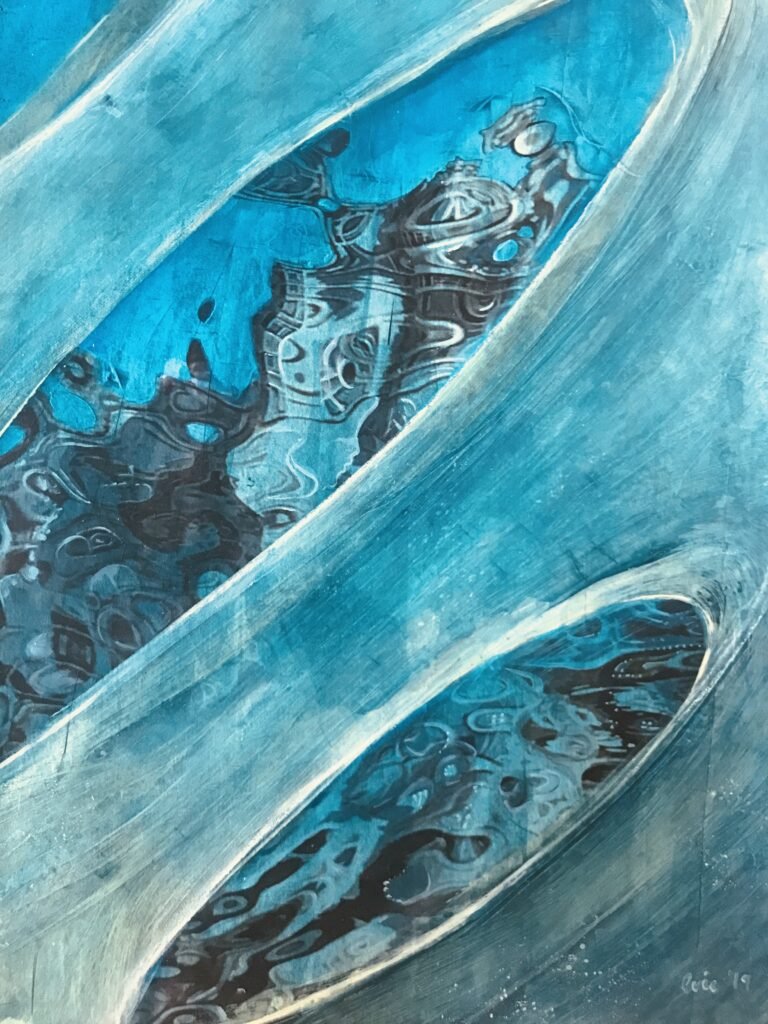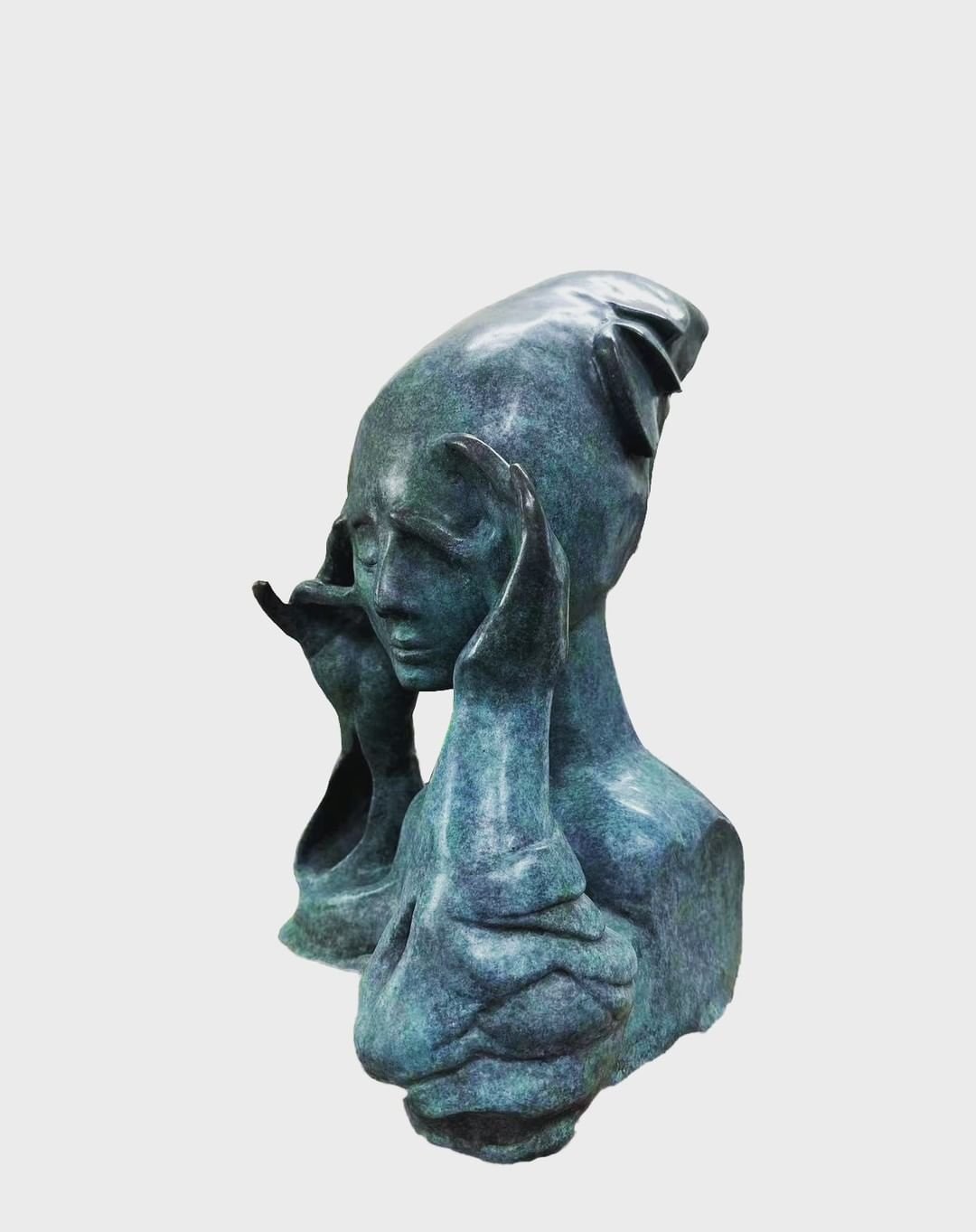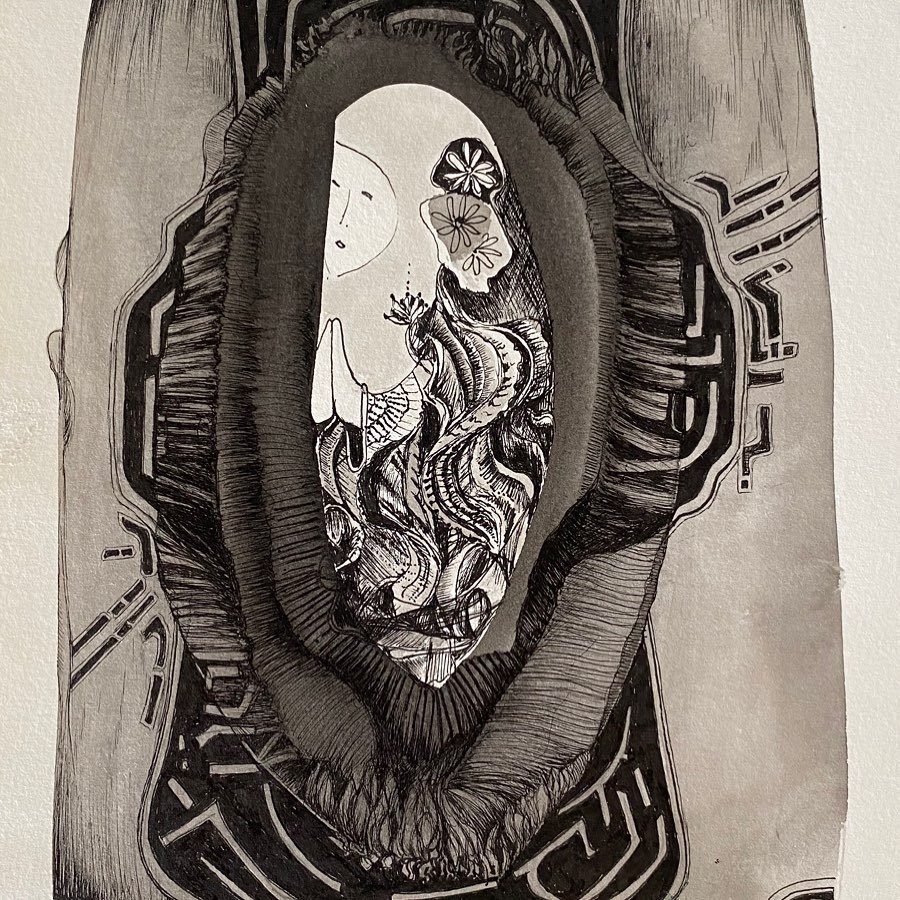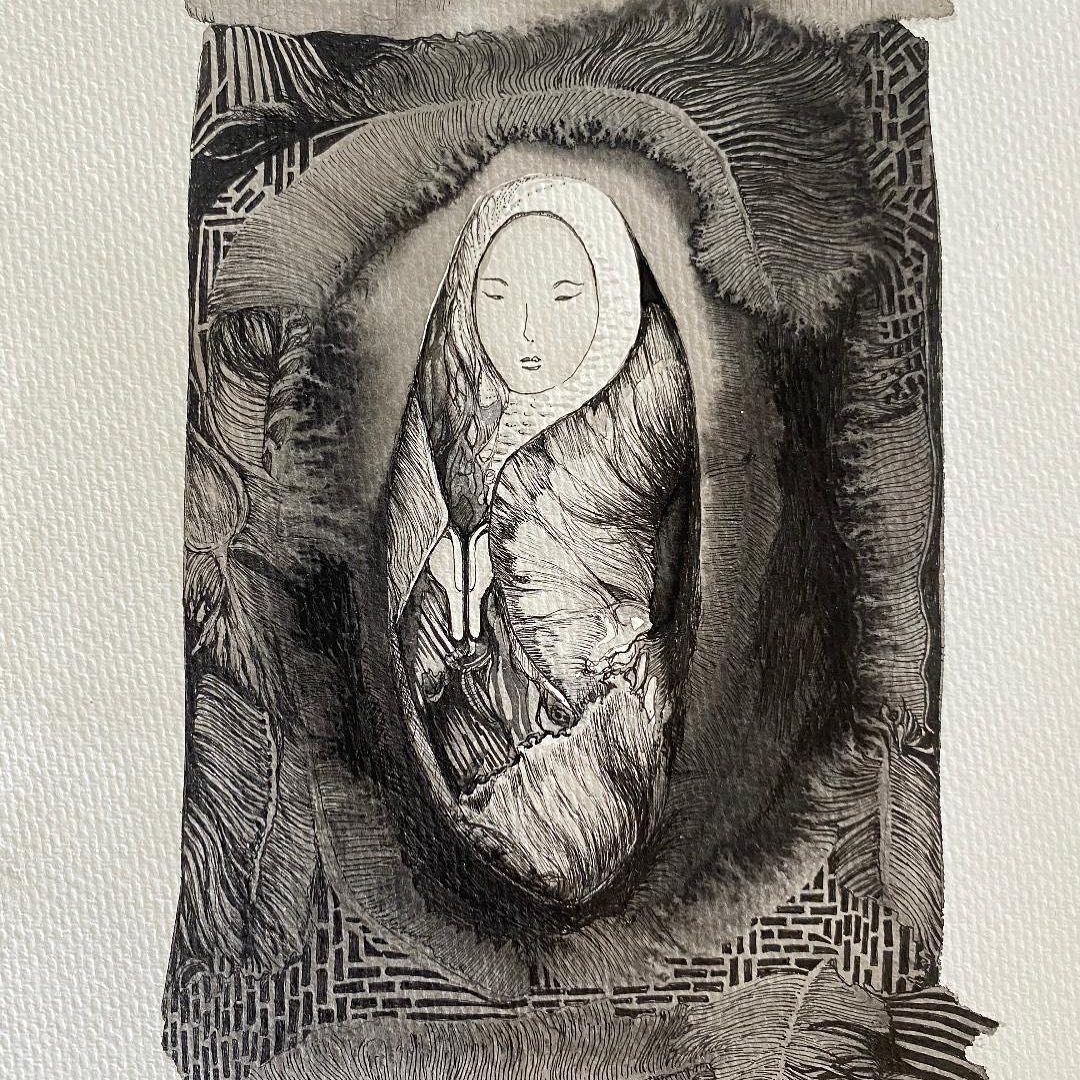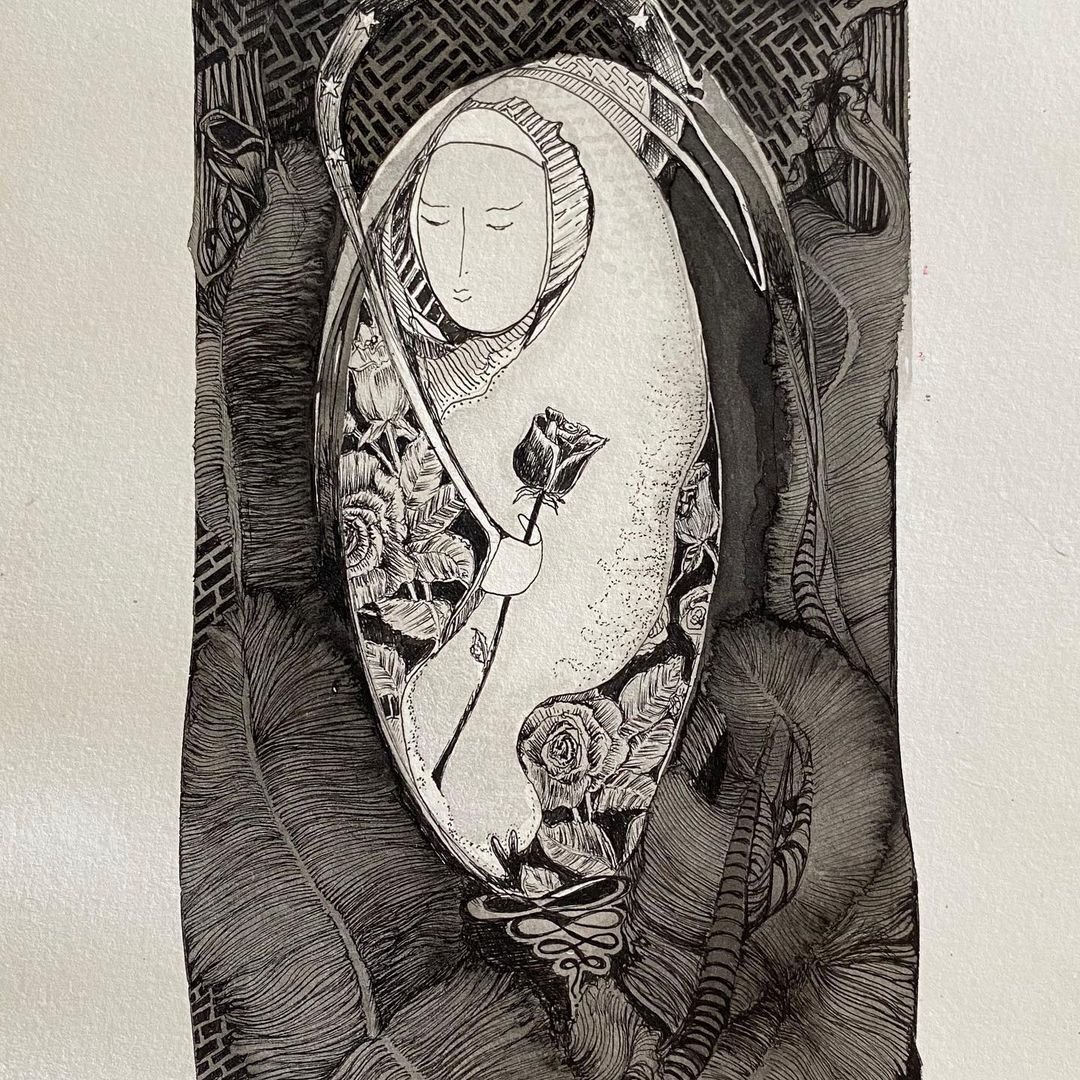Artist in conversation: Yvette Stride
“ I have this notion of having ‘sensitives’, which are like feelers or receptors out in the world, and they pick up things. Some things stand out more to me. ”
Yvette Stride is an Australian artist, currently living in Beijing, China. She holds a Bachelor's degree in Visual Art from the Queensland University of Technology and has amassed significant experience as an underwater videographer and a teacher at international schools. Yvette's work is heavily influenced by her connection to the metaphysical world, using vortices as a visual conduit to depict 'other-worldliness', dream states, and energy flows.
Her art is a journey towards truth and wisdom, focusing on communication across time, space, and diverse cultures. She brings attention to the potential pitfalls of miscommunication. Yvette finds inspiration in the metaphysical realm, drawing upon its wisdom and incorporating it into her work through symbolic imagery like ancient scrolls, quills, and vortices. Her pieces serve as a testament to her unique artistic vision and philosophical exploration, setting her apart in the contemporary art scene.
| Instagram |
What initially inspired you to become an artist, and how did you develop your unique style?
I’ve always been an artist, the issue was figuring out how to fund it. I remember creating a painting of three fish, when I was five years old, one fish was facing the front and I felt like it had power! My parents supported me by buying acrylic paints, a screen-printing set and Lino tools when I was 12. The fluidity of liquid ink caught my attention at school when I was about 14, prompting an appreciation for curvy-linear work, like that of Australian artist Sydney Long, Art Nouveau, the Ukiyo-e printmakers, and then probably most significantly Aubrey Beardsley. Vortices came into my work around the age of 16 and have stayed. My Art teachers, Adrian Schaefer and Shelly Kelly were instrumental in instilling creative confidence, in my small coastal town in NSW, Australia. This was consolidated and pushed into conceptual realms at Queensland University of Technology (QUT) where I studied Visual Art and attained my bachelor’s degree. No one thought a Fine Art degree was a smart choice, in terms of finances. Yet, the employment choices I made to fund my art have ended up contributing to my practice, like all my experiences really. For me, being sensitive in this way, meant I didn’t really have a choice, it is who I am. Or perhaps it’s just a part of me I wasn’t ever willing to give up.
In terms of subject matter, what themes or motifs do you frequently explore in your work, and what draws you to these topics?
Vortices, as mentioned, recur. Probably, before I could conceptualize or vocalise it, my work has been about connection with the metaphysical world, and vortices provide a visual link to that. I understand this as ‘other worldly, dreaming and energy’. Even the fish I drew at five years old, I had seen previously in a waking dream. Which is interesting in retrospect, because I later went on to become a scuba diving instructor and videographer, working in Australia, Papua New Guinea and the Cook Islands. So, some underwater imagery comes from there.
I find neutral buoyancy like being in a meditative state. Not surprisingly then, the colour blue and bluey greens predominate in my work (when I include colour) along with any combination of images or techniques that help give an ethereal feel. Brett Whitely advocated, the curve as the most spiritual form, and Kandinsky believed, blue was the most spiritual colour. I am interested in these ideas and the concept of eternity.
The works are basically about the search for truth and wisdom especially the communication across time, space and culture, highlighting the potential for miscommunication. The metaphysical world as a source of wisdom is referenced through the imagery, especially ancient scrolls, quills and vortices. Text is jumbled and layered, intertwining with the imagery, showing our curiosity to find unknowable answers.
Subjects in my art, are always whatever is relevant in my daily life, my life and my art are not separate in that way. So, we see nature, ocean and education references. For example, the patterns on shoe treads, scuba references, words in conversation or text, leaves I find on the ground etc. I am always observing and collecting data as I wander through my daily routines. I am naturally someone who sketches/draws, but my concept-based training at QUT opened doors to a more critique-oriented practice, so my works can be made from anything really. My last work shown in Australia was a video work, ‘Temporality and Solace’ created on my phone during quarantine in Hong Kong, 2020. My most recent work being shown in China, ‘Intrepid Union’, is a mixed media wearable artwork about cultural exchange. I create to investigate topics, to heal and communicate but ultimately to know myself better (Avant Garde artist Heidi Bucher is an advocate of this relationship to her art).
I have this notion of having ‘sensitives’, that are like feelers or receptors out in the world, and they pick up things. Some things stand out more to me. Computer algorithms have challenged this ability in recent years, because connections you may have otherwise interpreted as a meaningful co-incidence, are now manufactured. Lately my work has become more about communication, education, and shared cultural experiences. Probably because I have been living in China for ten years, working at international schools.
How do you navigate the balance between self-destruction and re-creation as a way towards conscious Happiness?
Is there an assumption here, that the creative process embodies self-destruction, and conscious happiness in some capacity? I don’t disagree, but perhaps not all artists are growth oriented in this way?
Still, I will try to answer the question. My approach focusses more on how I ride the ups and downs and not letting them dictate to me. It’s about creative sustainability. My objective as an artist, and a person is to balance the logical linear forces with intuitive the ones. I find that economic rationalism/capitalism is the greatest threat to my operating intuitively in the world. Because it means my life is governed by schedules and routines outside of myself. So, I have to be really conscious of my time, and create space to allow my intuitive voice some airtime and action time. This involves slowing down, and being still enough inside, to hear it and spending time in nature. Also, on a practical level this means writing/sketching in my diary, yoga and mediation, walks etc.
Can you discuss a specific piece or project that challenged you as an artist, and how you overcome those challenges?
Yes, this project, December long Night’s moon, is a good example. It was set as a December only project, as a type of ‘end of year’ winter solstice reflection (like Yultide or Advent in a way), one paper tile inked per day. But after day sixteen, I was simply too busy with holiday preparations, so I had to put the work away until the next December. And I continued with other works, until the following year. It took three Decembers in the end, to complete three panels. The work on display in London and Athens is the first panel, but there are two other panels as well. The work was stored in my lounge room in my small studio space in my apartment in China. It waited for me, stuck to the floor under a rug for a few years, under a soft scarf. And had to be carefully shipped to Australia during the pandemic, I felt a little panicky to be separated from it, it’s a very personal work. It was finally completed in Australia, across two countries. I only started showing this work, this year.
How do you stay connected with other artists and keep up with new developments and trends in the art world ?
Many ways. Trends are not something that interest me, but new developments in technology for displaying work are great to know about, and feeling connected is really important.
Mostly through personal connections with artists and brilliant people I’ve met on Art residences, especially from Guanlan Printmaking base in Shenzhen. I engage in challenges with the International Shenzhen Artist Forum (ISZAF) stay connected to happenings in Beijing through Red Gate Gallery, China. The Art Space Urunga in Australia also offers interesting opportunities and helps me feel closer to home. Being involved in Art education helps me stay up to date, through the teaching network and you can source educational documents from most major National Galleries. I subscribe to the New South Wales art gallery newsletters, and like reading Sophia Cai’s (Melbourne based art writer/curator) outlook on the Arts. UCCA, Song Museum, Red Brick Gallery and 798 art district in Beijing are also some of my other favourite hubs. But my all time favourite gallery is the Queensland Art Gallery, in Brisbane, Australia. I love the architecture, the warmth and the openness with connection to nature strips and outdoor art. They also host the Asia Pacific Triennial (APT), a show that blends concepts across eastern and western philosophies, which fits with my life experiences and outlook.
How do you incorporate feedback from critics and audiences into your artistic practice, and how do you balance this feedback with your own artistic intuition?
Ultimately, I trust my ‘sensitvities’, to help guide me. If something feels right to explore, I will pursue it. This goes for life and art.
Still, good criticism helps you define and refine your work. It is important to have good critical friends and I feel lucky to have two Art and Design teachers I have taught with across two international schools; I call them the Vikings. They are ruthlessly honest and great innovators. We have a culture of honest feedback, reciprocated between us. From there you can take it or leave it. This can also be said of my siblings. They are honest and reliable in elucidating potential miscommunications of my artwork in the interpersonal realm (I can become stuck inside the intrapersonal one sometimes).
How do you stay motivated and inspired despite any setbacks or creative blocks you may encounter?
Figure drawing will always help me move forward, friends sometimes drag me into a show with them, or a 30-day art challenge with ISZAF. Sometimes, something simpler like, a walk or some yoga breathing helps. Long beach walks if I am home are important. I don’t really have creative blocks, but setbacks I am very familiar with especially with time and money. Generally, I follow the resilience processes from my research on manifesting resilience in art classrooms, with A. Cutcher http://ijea.org/v16n11/ . I am conscious of balancing the promoting (risk) and protecting (comfort zone) factors in my life. This helps to build resilience, and I teach my students this too. It is a complex dynamic, but if you’ve been working with it for a while, it can really help you manage yourself.
How do you feel about exhibiting your artworks with The Holy Art Gallery?
Curious, because I wasn’t expecting to do it, and I think the Gallery has a different reach that might suit the work I selected to show. And this work has previously been kept quite private. Also, it has been a leap of faith really because I am used to showing in the Asia Pacific region. But since committing to the show, I see how professional the organisation is, and this makes things very easy and exciting. I feel like The Holy Art Gallery will help build my social media presence, which I need collaborative help with for sure. It is also always a good feeling, to have people believe in your work and want to promote it to others. I am grateful.
Looking ahead, what are your long-term goals and aspirations as an artist, and how do you plan to achieve them?
Long term, I want to be part of making a difference to how creativity is taught and how it fits into society. It is important to me to help promote self-connection, awareness, and healing through Art. So, speaking on Art education at EARCOS (with a colleague) is a goal, to help support younger people in perusing wellbeing/growth through art. Being part of a community involved in protecting the natural world is something I will be seeking also, since for me it is a great source of inspiration and rejuvenation. Sustainability and healing through art are my big aims and I’ll need to strengthen connections to larger communities already doing this. Rebuilding my website is one way to do this, happening next year.



